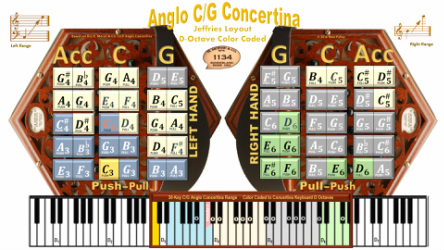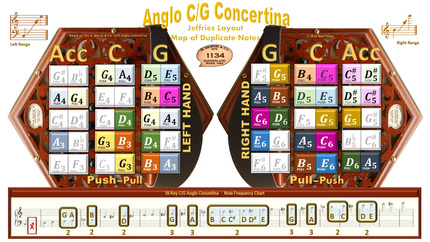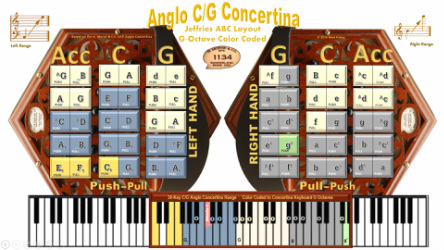MAPS OF THE ANGLO CONCERTINA KEYBOARD
|
The Complexity of the Concertina
One doesn't have to tune a well-conditioned concertina. You don't have to scratch a bow across it or blow uncertainly into it. In short, the first note you play on it comes easily and sounds pretty good. It's all the many notes that follow the first one that are difficult. I recently acquired a new concertina, newly made by R. Morse and Co. of Sunderland, Massachusetts. One of the first challenges for a newbie is that the thing has 30 keys. It is a diatonic instrument meaning that each key produces a different note whether the bellows are pushed or pulled. The resulting 60 notes is a geographical challenge. Tutors such as the estimable Edel Fox and Ernestine Healy on the Online Academy of Irish Music mention the necessity of a good map of the keyboard. I may be a struggling novice with the concertina but have some capability with computer graphics. So I put together six different explorations of the keyboard, initially just for my own use. |
Subsequently I thought that they might be of use to others in the same boat as myself, or of interest to those just intrigued by this unusual and complicated instrument.
The version of the concertina most commonly used in Irish music is the 30-key so-called Anglo Concertina where the first inner row of keys is tuned to the key of G and the middle row to the key of C. To thoroughly discombobulate the novice, there is an outer row that has a mixum-gatherum of sharps, flats and stray duplicates of notes already present in the first two rows. Further confusing matters is the fact that most Irish music is in the keys of G and D – not accidentally, one presumes, the first two strings on a violin. G/D Anglo concertinas are, in fact, made but it seems that a G/C concertina is better for G/D Irish music than a G/D concertina is. In short, a novice needs a decent map to navigate the concertina keyboard. Hopefully, the several maps on this page fulfills that need. To my knowledge, there is nothing comparable available on the Internet – otherwise, I wouldn't bother providing the material here. |
Map I: Keyboard Color Coded to G scale

The first picture is a straightforward map of the instrument and its relationship to a piano keyboard. Pictured are the three rows on each side of the concertina –
the G, C and Accidentals rows. The C/G 30-key Anglo has a range of three and a half octaves starting from the C below middle C. The D in the lowest scale is skipped as are several accidentals in the lowest and highest scales.
|
The keyboard in this picture is color coded to G octaves, one of the two most commonly used keys in Irish Traditional Music (ITM). The first G (on the bottom row of the instrument) corresponds to the G of the first open string on the violin. There are three octaves on the concertina above this bottom G.
The G scale can be easily played using the concertina's native G (first) row but it can also be played starting in the C row and borrowing the F# from the G row. Outside of being big, color coded, readable and expressly designed for printing and laminating, there are two other aspects of the presentation in these maps that are somewhat unusual:
|
|
Map Ii: keyboard Color Coded to g scale

Map II is the same as Map I except that the color coding is to D octaves, the tonic of the second most common scale in ITM.
Since the time I studied music at a rudimentary level in school, a new system of representing it, called ABC notation, has been developed. Not being used to it, I find it difficult to read ABC notation but it has the benefit of not needing musical staves. Maps III and IV use ABC notation for the benefit of those who use the system.
MAP V: COLOR CODING OF DUPLICATE NOTES

If one counts the notes marked on the piano keyboards above, the total comes to 38. There are 60 notes Anglo 30-key keyboard (two for each button). This means that there are 22 notes that are duplicates, with most of the notes in question being available once when the bellows are pushed and the other when they are pulled.
This is an extremely important and useful feature of the instrument since it is often desirable to have either a push or a pull version of a note available depending on the context. The location of these duplicates is another challenge for the newcomer. They are highlighted in Map V. There are three instances of G and A in each of the two octaves above middle C. Fourteen other notes occur twice and 20 occur just once (with 4 X 3 + 14 X 2 + 20 = 60).
This is an extremely important and useful feature of the instrument since it is often desirable to have either a push or a pull version of a note available depending on the context. The location of these duplicates is another challenge for the newcomer. They are highlighted in Map V. There are three instances of G and A in each of the two octaves above middle C. Fourteen other notes occur twice and 20 occur just once (with 4 X 3 + 14 X 2 + 20 = 60).
Map VI: MAP OF KEYBOARD TO TREBLE AND BASS CLEFS

Map VI projects the keyboard onto the treble and bass clef –
a picture I call the Clef Notes page.
PDFs of the Keyboard Maps
|
On the right are links to 2-page pdf files that are suitable for back-to-back printing and lamination (on either 8.5X11 or A4 paper). One probably needs a fairly decent printer but no special paper is needed. In the U.S., I have successfully had them laminated at the Staples chain of office supply stores using 7mm lamination covers.
|
U.S. Paper Size (8.5 X 11)
[Left-Click to view in Browser; Right-click to download] |
Metric Paper Size (A4)
[Left-Click to view in Browser; Right-click to download] |
The keyboard maps may be reproduced free of charge for non-commercial use including reasonable numbers for personal instructional purposes by tutors/teachers. Copies of the maps may not be mass produced or sold commercially.

